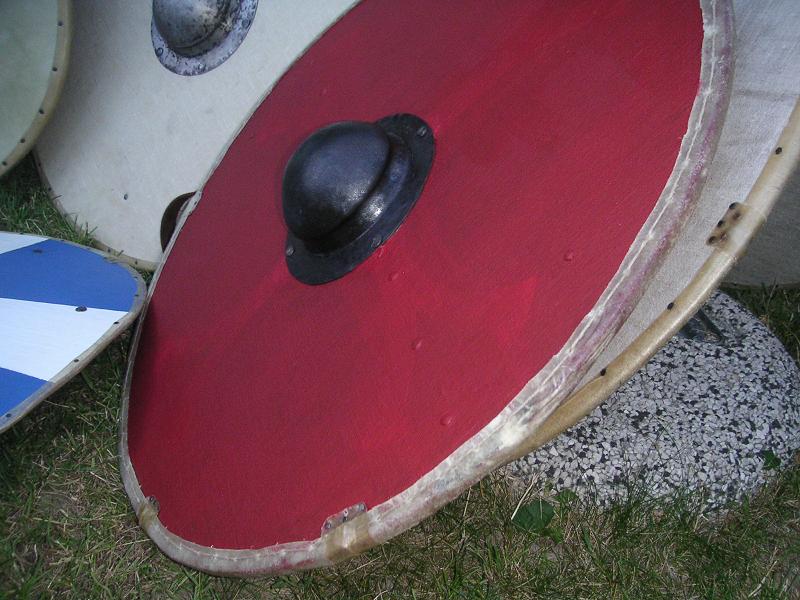| Author |
Message |
Artis Aboltins

|
 Posted: Wed 20 Jan, 2010 2:34 pm Post subject: Construction of Vendel period shield bosses Posted: Wed 20 Jan, 2010 2:34 pm Post subject: Construction of Vendel period shield bosses |
 |
|
|
Greetings! As most of you are well aware, the form of the shield bosses from the Vendel period is rather diferent from the ones used later - many of them tend to have the characteristic "mushroom" shape and also a decorative knob on top of the hemisphere, not to count the decorative plaques. The question is, how was the umo itself made? was it rised from one piece or was it combined? I am asking that because it seems that the umbo from the Valsgarde 8 grave shield 1 seems to be described as consisting of two separate parts. Perharps someone have more info on that?
|
|
  |
 |
|
Viktor Abrahamson
|
 Posted: Wed 20 Jan, 2010 11:40 pm Post subject: Posted: Wed 20 Jan, 2010 11:40 pm Post subject: |
 |
|
It is possible to make mushroom shaped bosses in one piece (I attach an example i have made, without the knob).
But if that is the historical way or not , I donīt know.
In I.P. Stephensonīs book "The anglosaxon shield" they discuss the construction. One or two piece.
I attach a picture from the book (if this is not allowed? admin can remove the picture)
/Viktor
 Attachment: 86.59 KB Attachment: 86.59 KB

 Attachment: 55.23 KB Attachment: 55.23 KB
[ Download ]
|
|
    |
 |
Artis Aboltins

|
 Posted: Thu 21 Jan, 2010 1:21 am Post subject: Posted: Thu 21 Jan, 2010 1:21 am Post subject: |
 |
|
|
Thanks for input, Viktor! Yes I know it is quite possible to do mushroom shaped bosses from one piece - been dooing it myself too, however, the note in Valsgarde 8 book describing the umbo as consisting of two distinct parts - hemispherical top and the "neck". Hence I was wondering about the proper method of making the replica...
|
|
  |
 |
|
Viktor Abrahamson
|
 Posted: Thu 21 Jan, 2010 2:05 am Post subject: Posted: Thu 21 Jan, 2010 2:05 am Post subject: |
 |
|
The two piece construction theory in the drawing might be the proper way of doing it.
With old low carbon iron itīs quite easy to forgeweld, but to achive a strong weld like that look rather tricky to me.
/Viktor
|
|
    |
 |
Artis Aboltins

|
 Posted: Thu 21 Jan, 2010 2:35 am Post subject: Posted: Thu 21 Jan, 2010 2:35 am Post subject: |
 |
|
|
I am actually wondering why they would be dooing it, as, in my experience, once you get ahold of correct technique, drawing it out from a single plate is not too hard - same would go for bilet flattened into plate I'd guess. After all, all you need is a hammer and some surface to work on - of course, a couple of tools come in really handy, but...
|
|
  |
 |
|
Viktor Abrahamson
|
 Posted: Thu 21 Jan, 2010 3:17 am Post subject: Posted: Thu 21 Jan, 2010 3:17 am Post subject: |
 |
|
If you know you can do the weld fast and without problem, then it might be a faster way to construct it than working the bill out the whole way. This is just speculation.
How about the knob, is it usually riveted or shaped out of the same piece as rest of the boss?
/Viktor
|
|
    |
 |
Artis Aboltins

|
 Posted: Thu 21 Jan, 2010 4:08 am Post subject: Posted: Thu 21 Jan, 2010 4:08 am Post subject: |
 |
|
|
I think it is a separate part - at least, in Valsgarde 8 case - the knob has too strict lines.
|
|
  |
 |
|
Matthew Amt
|
 Posted: Thu 21 Jan, 2010 6:57 am Post subject: Posted: Thu 21 Jan, 2010 6:57 am Post subject: |
 |
|
Avete!
There was some discussion along these lines on the Armour Archive a while back, about Saxon bosses. Bruce Blackistone had been doing some study and experimentation on the subject. As I recall--and I may be misremembering!--there wasn't any actual evidence of the 2-piece construction, no welds detected so far. Granted, that's not saying much, since probably very few had been examined with X-rays and such. But Bruce was seeing that bosses like this tend to be thickest in the middle, which didn't make much sense if they were dished or raised from a more-or-less flat plate. His tentative theory was that they could have been raised from a tube or cylinder, closing one end into a cone (or dome), and flanging out the bottom. That would make the top thicker than the sides, and the flange thinnest of all, which is how the originals seem to be. Then add the knob. Of course, this would still require one forge-weld, making the tube from a piece of sheet, and I don't know if anything like that has been detected, either.
Nice boss, Viktor!
Matthew
|
|
   |
 |
|
|

